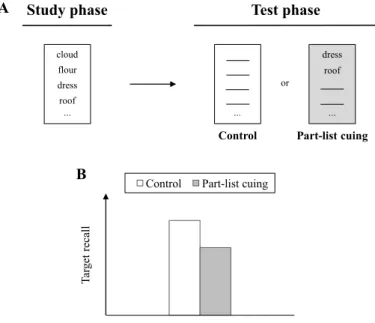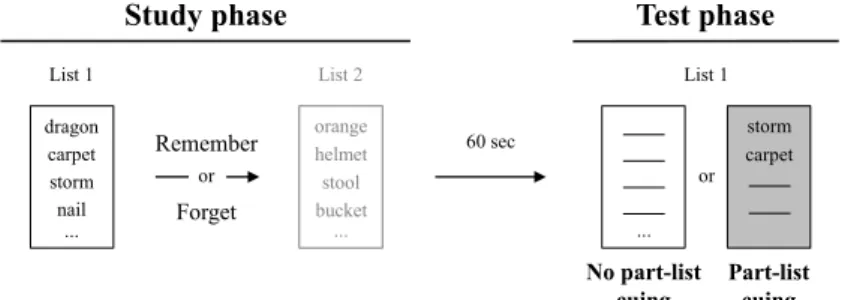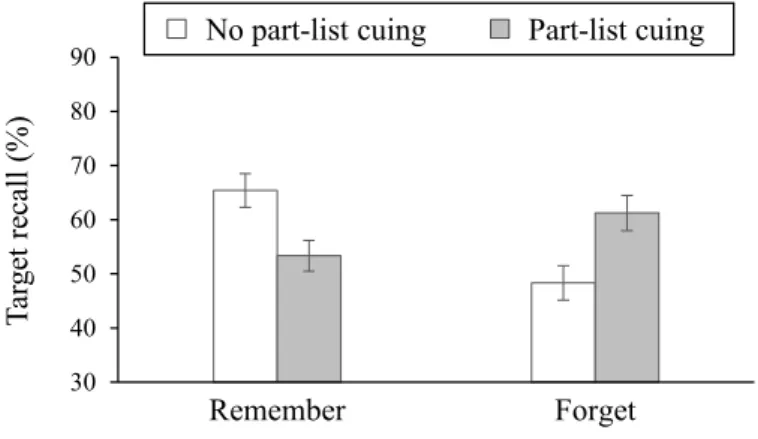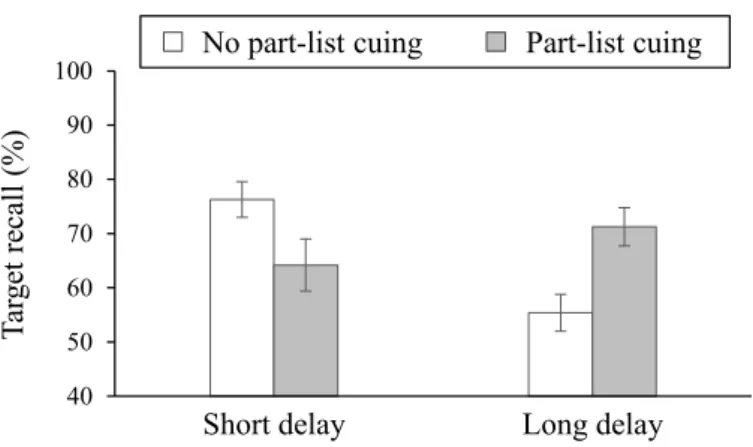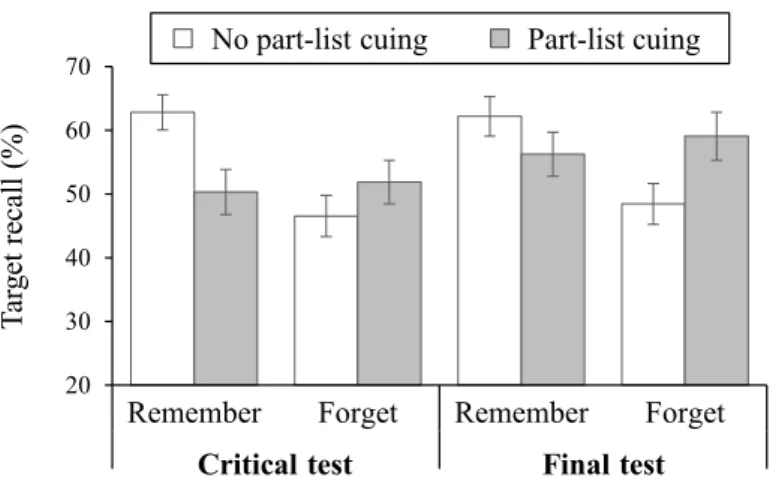Memory: The Many Faces of Part-List Cuing
Inaugural-Dissertation zur Erlangung der Doktorw¨ urde der Philosophischen Fakult¨ at II
(Psychologie, P¨ adagogik und Sportwissenschaft) der Universit¨ at Regensburg
vorgelegt von
Eva-Maria Lehmer
aus Regensburg
Regensburg 2018
First and foremost, I would like to express my special appreciation and thanks to my supervisor Prof. Karl-Heinz B¨ auml, who initiated this project and supported me in all time of research and writing of this thesis.
My sincere thanks go to my colleagues Julia Rupprecht, Lisa Wallner, Michael Wirth, Lena Abel, Oli Kliegl, and Bernhard Past¨ otter for sharing their expertise and providing helpful comments and motivation. It was a pleasure to work with you.
Further I would like to thank Petra Witzmann for her help with a lot of formal matters and the lab’s research assistants for their help with the data collection. Thanks to all the students and non-students who participated in the experiments.
I am also grateful to Dr. Michaela Ingrisch and Christina Decker, who made a financial support for this project possible.
I dedicate this work to my family, especially my parents, who always encouraged me in my future plans. Words cannot express how grateful I am for your loving support.
1
How can we gain re-access to contents and experiences that we have stored in our memory? This is one of the key issues in human memory research. If information were encoded and stored in memory but could not be re-accessed at a later point, it would be worthless. The concept of retrieval, i.e. the reactivation of acquired memories, remained somewhat neglected until the 1960s when Endel Tulving as one of the first reseachers of his time began to emphasize the importance of retrieval processes against the background of the previous behaviouristic view of stimulus-response associations and the main focus on storage. From the behaviouristic point of view, there was no need to distinguish between storage and retrieval and it was considered that recall performance directly reflected the information that had been successfully encoded and stored. Tulving, however, argued that much more information is stored in our memory than we can remember at a certain point in time and introduced the distinction between the availability and the accessiblity of particular memories. According to his view, information that is stored and theoretically available in our memory is accessible to retrieval only under certain circumstances (see Tulving, 1979). Thus, it is of great importance for human memory research to identify factors that determine successful retrieval.
An “extremly important factor in determining the level of recall” (Tulving
& Pearlstone, 1966, p. 216) is the presence of adequate retrieval cues, i.e. hints or clues that are present during a retrieval attempt and that have the capacity to evoke a particular memory. Tulving and his colleagues (Tulving & Osler, 1968; Tulving & Pearlstone, 1966; Tulving & Psotka, 1971) demonstrated in
2
numerous studies that the amount of information that we can retrieve depends crucially on retrieval cues provided at the time of recall. In a seminal study, Tulving and Pearlstone (1966) observed that people were able to recall more items of a categorized word list when the items’ category names were reexposed at test to serve as retrieval aid and thus provided first empirical evidence that retrieval cues allow us to get access to information that we otherwise would not be able to retrieve.
There is a multiplicity of things that can aid and guide our retrieval as cues. For instance, the shopping bag on the chair may remind us that we have planned to do our weekly shopping today. Or, when a workmate tells us about a delicious meal in a fancy restaurant last night, it will remind us of our great birthday party in the same restaurant two months ago. In a diary study, Wagenaar (1986) showed that the recall of autobiographical events can significantly improve if information about single aspects of the event - like persons involved or the location of the event - is provided during retrieval. Eventually, Wagenaar found that he was able to recollect most of the events even after six years, given a sufficient number of retrieval cues.
Similarly, retrieval may benefit also from more general, contextual cues like the environment in which a memory trace was originally encoded (see Smith &
Vela, 2001). In a often-cited study, Godden and Baddeley (1975) impressively demonstrated that items studied and tested in the same environment were better recalled than those for which study and test contexts differed. To this end, deep-sea divers learned a list of words either on dry land or under water and subsequently engaged in a recall task either in the same environment as during encoding or in the different one. Actually, when the divers learned and retrieved the words only on land or only under water, recall was better than when the environment changed.
The associative and organizational theories of memory that became
influential in the 1960s and 1970s explain the beneficial effects of retrieval cues
by associative connections that were formed between cue and target memory
during encoding (see Anderson, 1972; Collins & Loftus, 1975). Ever since
Aristotle (cf. Roediger, 1978), it has been assumed that associations between single memory items may, at least in part, guide and support the retrieval of a particular memory. The activation of one of these items during retrieval, like the presentation of a category label or even the original environment as retrieval cue, may increase the accessibility of related items by a process called spreading activation. The main idea of spreading activation is that a given memory trace automatically spreads activation to other associatively related memories, which in turn increases the likelihood that these related memories get retrieved. The concept of spreading activation across interitem associations is a core feature of many theories of memory, and can illustrate clearly how retrieval cues make memories accessible. It found its way also into applied memory research and is implemented, for example, in the cognitive interview of eyewitnesses (Geiselman, Fisher, MacKinnon, & Holland, 1985), an interrogation technique that provides known details of an event as retrieval cues.
However, during about the same period, a number of studies started to
question the generality of spreading activation processes by showing that the
provision of retrieval cues does not always improve retrieval but may even
hinder it (e.g., Roediger, 1973; Slamecka, 1968). The results of a study of
Slamecka (1968) constituted a cornerstone for it and initiated a rethinking
process on the effects of retrieval cues. Originally, Slamecka (1968) also
intended to prove the theoretical view that making an item accessible may
aid the retrieval of associated items and reasoned that the faciliative effect of
associative connections might be demonstrated in a rather direct way when a
subset of items from a previously studied word list was provided as retrieval
cues for the rest of the list. For this purpose, he conducted a series of
experiments, in which he varied the testing conditions between two groups
of participants. After study of a word list, an experimental group received
a random subset of the list items as retrieval cues and were asked to recall
the remaining items. In contrast, the control group received no such cues
and tried to recall the entire list in a free recall task. Slamecka expected to
demonstrate that the recall of the uncued target items would be superior in the experimental group than in the control group because of the activation of otherwise inaccessible associative connections. However, to his big surprise, he repeatedly found that the presentation of retrieval cues did not facilitate but even impaired the recall of the remaining items - a finding that became known as part-list cuing impairment in memory research.
Even though the finding seems quite counterintuitive and at odds with the common theories of human memory, it has been replicated and extended in a vast number of subsequent studies that consistently reported detrimental effects of part-list cues (for reviews, see Nickerson, 1984; Roediger & Neely, 1982). Part-list cuing impairment has proven to be very robust and has arisen over a wide range of study materials (Brown, 1968; Slamecka, 1968; Sloman, 1991), testing procedures like recall, recognition, and reconstruction tasks (Kelley & Bovee, 2007; Oswald, Serra, & Krishna, 2006; Todres & Watkins, 1981), and in different participant groups (B¨ auml, Kissler, & Rak, 2002;
Christensen, Girard, Benjamin, & Vidailhet, 2006; Marsh, Dolan, Balota, &
Roediger, 2004; Zellner & B¨ auml, 2005). Numerous theoretical explanations have been also developed to account for the effects of part-list cuing. However, even 30 years after its first demonstration by Slamecka (1968), part-list cuing continued to remain “something of an enigma in memory research” (Nickerson, 1984, p. 551) and it was still unclear how the effect arises. The basic assumptions that nearly all of the theories during this period had in common were that part-list cuing is always detrimental to the recall of the remaining items and that a single mechanism is responsible for the effect.
In more recent years, new findings have challenged these basic assumptions and have thus influenced the way of thinking about part-list cuing. One of these findings is the demonstration that part-list cuing impairment cannot be sufficiently explained by one cognitive mechanism, but that more than one mechanism may mediate the effect. Two studies of B¨ auml and Aslan (Aslan
& B¨ auml, 2007; B¨ auml & Aslan, 2006) showed for the first time that quite
different mechanisms may be involved, depending on the encoding situation.
Items can be encoded in very different ways, and also in everyday life, we use different strategies to encode and store contents in our memory. For instance, we either may encode items each one by one or we may try to develop connections between the single items and build a serial retrieval plan. When part-list cues are provided at test, the way of encoding can then lead to the involvement of different cognitive mechanisms and can thus influence the effects of part-list cuing.
For decades, research focused almost exclusively on negative effects of part-list cuing on target recall. Thus, the second novel finding that part-list cuing may, under certain circumstances, also be beneficial for the remaining items came as a big surprise. Goernert and Larson (1994) examined the effects of part-list cues on a list of items that was intentionally forgotten after studying. Subjects studied a word list and were afterwards asked to forget the list and study another one. Nevertheless, at test, they were tested on even that list and received either a random selection of the list items as part-list cues or performed a free recall task. Goernert and Larson found that part-list cues enhanced the recall of the forgotten items and thus provided first evidence that part-list cuing can also improve target recall. The finding had not been replicated for a long time and remained almost disregarded in part-list cuing research during the following years until B¨ auml and Samenieh (2012) took up, replicated, and generalized the finding. They demonstrated that beneficial effects of part-list cuing can emerge with different forms of forgetting when the access to the original study context is impaired during testing, like after the instruction to forget the encoded material or after a prolonged retention interval between study and test (see also B¨ auml & Schlichting, 2014), and reasoned that the presentation of part-list cues may reactivate the original context and thus improve recall performance.
The present thesis is dedicated to clarify the open questions that arise from
these two lines of research, which are based on the findings of part-list cuing
impairment in different encoding situations and on the finding of part-list cuing
facilitation when study context access at test is impaired. Thus, it is intended
to contrast part-list cuing in different encoding situations and to underline that the way of encoding plays a crucial role for effects of part-list cues and the involved cognitive mechanisms. Additionally, the thesis aimes to examine if beneficial effects of part-list cues that, to date, have been demonstrated for one type of encdoing only generalize to further encoding situations. Indeed, current empirical support for beneficial effects is restricted to single study situations in which typically hardly any serial retrieval plans are formed by subjects.
Thus, in the present thesis, part-list cuing effects are investigated in conditions in which study context access is impaired at test and encoding conditions are employed that provoke the development of serial retrieval plans. In a further step, a repeated testing procedure is used in order to draw more precise conclusions about how part-list cues may affect the usage of a serial retrieval plan and thus influence recall performance in this type of encoding situations.
Finally, the present findings shall help to understand the mechanisms that may underly the effects of part-list cuing in different encoding and testing situations in order to determine the conditions in which part-list cuing may be beneficial or detrimental. As Roediger stated already 1973, it is a major challenge to the understanding of human memory to specify the conditions under which retrieval cues may improve or impair recall, and to develop a compelling theoretical account (see Roediger, 1973, p. 645). It is also of high practical relevance to be aware of the differing effects of cues depending on encoding and testing conditions in order to provide retrieval cues in an appropriate and useful manner in applied situations like educational or clinical settings or in eyewitness testimony.
The purpose of chapter 1 of this thesis was to give an overview of basic
concepts and empirical findings in research on part-list cuing. In a first step, it
introduces the basic experimental paradigm and findings. Then, the question
of the cognitive mechanisms mediating the detrimental effects of part-list cuing
and their dependence on encoding is discussed. In the second step, the findings
from more recent studies, that reported beneficial effects of part-list cuing, are
reviewed, and a theoretical account of the beneficial effect is provided. With
regard to the current state of research, chapter 2 specifies the goals of the
present experiments. In chapter 3, the experiments are introduced, methods
and results reported and subsequently discussed. Finally, in chapter 4, the
main findings are summarized and discussed. A multi-mechanisms account is
introduced that combines the findings on the detrimental and beneficial effects
of part-list cuing in different experimental conditions.
Abstract 13
1 The Effects of Retrieval Cues in Episodic Memory 14 1.1 Part-List Cuing . . . 15 The Part-List Cuing Paradigm . . . 16 The Generality of Part-List Cuing Impairment and its
Limitations . . . 18 1.2 Mechanisms underlying Part-List Cuing Impairment . 21 Single-Mechanism Accounts . . . 22 The Critical Role of Encoding for Part-List Cuing
Impairment . . . 26 1.3 Part-List Cuing Facilitation . . . 27 Evidence for Beneficial Effects of Part-List Cuing . . . . 28 A Context Account of Part-List Cuing Facilitation . . . 29
2 Goals of the Present Study 32
3 Experiments 37
9
3.1 Experiment 1a: Effects of Part-List Cuing in List-Method Directed Forgetting (Low Associative
Encoding) . . . 38
Method . . . 39
Results . . . 42
Discussion . . . 44
3.2 Experiment 1b: Effects of Part-List Cuing in List-Method Directed Forgetting (High Associative Encoding) . . . 44
Method . . . 45
Results . . . 46
Discussion . . . 48
3.3 Experiment 2a: Effects of Part-List Cuing after Short and Long Retention Intervals (Low Associative Encoding) . . . 49
Methods . . . 49
Results . . . 52
Discussion . . . 53
3.4 Experiment 2b: Effects of Part-List Cuing after Short or Long Retention Intervals (High Associative Encoding) . . . 54
Methods . . . 54
Results . . . 55
Discussion . . . 57
3.5 Interim Summary . . . 58
3.6 Experiment 3: Effects of Part-List Cuing in List-Method Directed Forgetting (High Associative
Encoding) Using a Repeated-Testing Procedure . . . . 61
Methods . . . 61
Results . . . 62
Discussion . . . 66
3.7 Experiment 4: Effects of Part-List Cuing after Prolonged Retention Interval (High Associative Encoding) Using a Repeated-Testing Procedure . . . . 67
Methods . . . 68
Results . . . 69
Discussion . . . 71
4 General Discussion 73 4.1 A Multimechanisms Account of Part-List Cuing . . . . 76
Low Associative Encoding . . . 76
High Associative Encoding . . . 77
A Multimechanisms Account . . . 78
4.2 Relation to Prior Part-List Cuing Work . . . 79
The Role of Encoding . . . 79
The Role of Study-Context Access . . . 81
4.3 An Evaluation of the Experimental Manipulations . . 82
Study-Test Cycles “versus” Story Building . . . 82
Directed Forgetting “versus” Time-Dependent Forgetting 83 4.4 Individual Differences in Part-List Cuing . . . 84
Working Memory Capacity . . . 84
Individuals’ Age . . . 86 4.5 Application of Part-List Cuing to Social Memory . . 88 4.6 Part-List Cuing Effects in Other Paradigms . . . 90 4.7 Summary of the Effects of Retrieval Cues with
Applied Perspectives . . . 92 4.8 Final Conclusions . . . 96
Literature 98
Parts of the present thesis are published as:
Lehmer, E.-M., & B¨ auml, K.-H. T. (2018). Part-List cuing can impair, improve, or not influence recall performance: the critical roles of encoding and access to study context at test. Journal of Experimental Psychology: Learning, Memory, and Cognition, 44, 1186-1200.
Lehmer, E.-M., & B¨ auml, K.-H. T. (2018). The many faces of part-list cuing -
evidence for the interplay between detrimental and beneficial mechanisms. Frontiers in
Psychology, 9, 701.
Retrieval cues play a crucial role for successful remembering in episodic memory. In contrast, research on part-list cuing - the presentation of a random selection of studied items as retrieval cues at test - has consistently reported a detrimental effect of part-list cues on recall of the remaining items. Depending on the encoding situation, which may favor the development of serial retrieval plans to varying degrees, part-list cuing impairment has been attributed to quite different cognitive mechanisms. In more recent years, some studies demonstrated that part-list cuing can not only impair, but also improve recall when context conditions after study are changed and thus access to the original study context at test is impaired. Current empirical support for the beneficial effect of part-list cuing is restricted to encoding situations in which typically hardly any serial retrieval plans are formed by subjects.
This thesis investigated how the type of encoding and access to study context at test affect the effects of part-list cuing. Experiments 1 and 2 showed that, depending on the combination of encoding and and study context access, part-list cuing impaired, improved, or did not influence recall of the target items. Experiment 3 and 4 focused on encoding situations in which serial retrieval plans were developed and demonstrated beneficial effects on the second test of a repeated-testing task, when part-list cues were provided on the first recall test but were removed on the second test. From these findings, a multimechanisms account is derived to explain how part-list cuing affects target recall in different conditions.
13
The Effects of Retrieval Cues in Episodic Memory
14
1.1 Part-List Cuing
Imagine you came back from a journey in Africa and you are asked by your friends to remember as many animals as possible that you have encountered on your trip. Then, when you have already listed all of them that came to your mind and someone else will provide you with the category name birds, you will probably be able to remember much more animals than before. Retrieval cues can play an important role for episodic recall. Analogous to the example above, laboratory work has consistently shown that recall of a previously studied categorized word list can be facilitated if the items’ category names or one instance of each category are presented as retrieval cues at test (e.g. Hudson
& Austin, 1970; Tulving & Pearlstone, 1966; Tulving & Psotka, 1971). In the first of these studies, Tulving and Pearlstone (1966) asked participants to study word lists comprising instances from different semantic categories with the items of the same category presented together and each preceded by the category name. Afterwards, during the test phase, participants either recalled as many items as possible in a free-recall condition or additionally received the category labels in the cued-recall condition. The main result was a large advantage of the cued-recall condition over the free-recall condition.
Additionally, when the latter uncued participant group subsequently received the category names as cues, they were able to recall many more words than in the free recall task before.
Recall can also benefit strongly from contextual features that are present during encoding and retrieval and that may act as retrieval cues. The term context refers to the general setting or circumstances in which an event occurred and which are stored with the particular contents in our memory.
For instance, it was repeatedly demonstrated that the overlap of the physical environment, like the room in which material was learned and tested, can improve recall performance (Godden & Baddeley, 1975; Smith, Glenberg, &
Bjork, 1978; Smith & Vela, 2001). However, the concept context contains
also the learners internal environment like their physiological state (e.g., being tired, excited, drunk, or tranquilized). Goodwin and his colleagues (Goodwin, Powell, Bremer, Hoine, & Stern, 1969), for example, reported clinical and laboratory evidence that information that was encoded when participants were drunk was remembered best when participants were drunk again at recall.
Another internal context that may influence retrieval is mood or emotion;
memory contents that are encoded in a given mood, whether positive, negative or neutral, are best recalled in even that mood (Bower, 1981; Eich, Macaulay,
& Ryan, 1994). The influence of contextual information on recall performance is reflected in the so-called encoding specifity principle (Thomson & Tulving, 1970; Tulving & Thomson, 1973). Encoding specifity means that the ability to retrieve particular memory entries depends critically on the match between encoding and retrieval contexts.
However, an opposing line of laboratory research suggests that retrieval cues do not always improve recall performance. About five decades ago, first empirical evidence emerged that the beneficial effect of cuing may even reverse into a detrimental effect when a subset of previously studied items are presented during recall (Slamecka, 1968; Roediger, 1973). In the following years, the detrimental effect of cues was replicated by a large number of studies, employing the so-called part-list cuing paradigm. Considering the multitude of empirical evidence for beneficial effects of retrieval cues, the finding is indeed surprising and quite counterintuitive and has motivated much research and theorizing on this topic. In the following, the basic paradigm will be introduced and the variety of replications in different experimental settings will be described.
The Part-List Cuing Paradigm
In a typical part-list cuing experiment, participants study a list of words
and, after a short distractor task, receive either several items as retrieval cues
for recall of the remaining items or perform a free recall task in the absence
of any retrieval cues. This paradigm was originally introduced by Slamecka (1968) in a series of experiments in which he repeatedly varied the presentation of retrieval cues on a final recall test. For example, subjects studied a list of 30 words and subsequently attempted to recall the items. However, on the final test, participants in the experimental condition were given a randomly chosen half of the list items as cues and were asked to recall the remaining (target) items. Participants in the control condition were asked to recall as many of the items as possible of the entire list in a free recall task. Recall performance for the target items in the experimental condition was compared with recall for the same items when no cues were given in the control condition. As an intriguing finding, recall of the target items was impaired by the presentation of part-list cues in the experimental condition relative to recall in the uncued control condition (see Fig. 1).
Although initially dismissed as a procedural artifact (Slamecka, 1968, p.
510), research on part-list cuing has attracted the attention of many memory researchers in the following decades after Slamecka’s discovery. For instance, Roediger (1963) presented word lists consisting of blocked exemplars of several semantic categories and then conducted a recall test in which participants were provided with either category names as retrieval cues or additionally received a varying number of category instances. Subjects who were cued with additional instances recalled a significantly smaller proportion of the target items than subjects in the control condition who received category names as cues only.
Additionally, the detrimental effect of part-list cuing increased as the number
of instances given as cues increased. Roediger reasoned that cuing may impair
recall when more cues are presented than is necessary to activate higher order
units such as categories. Numerous studies have reported analogous findings of
a detrimental effect of part-list cuing, referred to as part-list cuing impairment
in the following (for reviews, see Nickerson, 1984; Roediger & Neely, 1982).
Target recall
Control Part-list cuing or
Control ...
Part-list cuing dress
...
roof
Test phase Study phase
roof cloud flour dress
...
B A
Powered by TCPDF (www.tcpdf.org)
Powered by TCPDF (www.tcpdf.org) Powered by TCPDF (www.tcpdf.org)
